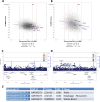Family-based whole-exome sequencing implicates a variant in lysyl oxidase like 4 in atypical femur fractures
- PMID: 39485938
- PMCID: PMC11700580
- DOI: 10.1093/jbmr/zjae175
Family-based whole-exome sequencing implicates a variant in lysyl oxidase like 4 in atypical femur fractures
Abstract
Atypical femur fractures (AFFs) are rare adverse events associated with bisphosphonate use, having unclear pathophysiology. AFFs also cluster in families and have occurred in patients with monogenetic bone diseases sometimes without bisphosphonate use, suggesting an underlying genetic susceptibility. Our aim was to identify a genetic cause for AFF in a Caucasian family with 7 members affected by osteoporosis, including 3 siblings with bisphosphonate-associated AFFs. Using whole-exome sequencing, we identified a rare pathogenic variant c.G1063A (p.Gly355Ser) in lysyl oxidase like 4 (LOXL4) among 64 heterozygous rare, protein-altering variants shared by the 3 siblings with AFFs. The same variant was also found in a fourth sibling with a low-trauma femur fracture above the knee, not fulfilling all the ASBMR criteria of AFF and in 1 of 73 unrelated European AFF patients. LOXL4 is involved in collagen cross-linking and may be relevant for microcrack formation and bone repair mechanisms. Preliminary functional analysis showed that skin fibroblast-derived osteoblasts from the unrelated patient with the LOXL4 variant expressed less collagen type I and elastin, while osteogenic differentiation and mineralization were enhanced compared with 2 controls. In conclusion, this LOXL4 variant may underlie AFF susceptibility possibly due to abnormal collagen metabolism, leading to increased formation of microdamage or compromised healing of microcracks in the femur.
Keywords: LOXL4; atypical femur fractures; bisphosphonates; collagen; family study; osteoporosis; whole-exome sequencing.
Plain language summary
Atypical femur fractures (AFFs) are rare fractures of the upper leg that can occur in people using bisphosphonates for osteoporosis. Genetic factors may play a role. We studied a family with 7 members affected by osteoporosis, including 3 siblings who developed AFFs after using bisphosphonates. In this family, a rare variant in the LOXL4 gene was identified as a potential cause for AFFs. This variant was also present in another sibling who had a different type of upper leg fracture, and in 1 of 73 unrelated European patients with AFFs. LOXL4 is involved in collagen cross-linking, a crucial bone formation process. The variant may impair collagen metabolism, leading to increased microdamage or compromised bone healing, which could increase the risk of AFFs.
© The Author(s) 2024. Published by Oxford University Press on behalf of the American Society for Bone and Mineral Research.
Conflict of interest statement
P.R.E.: Research funding from Amgen, Sanofi, and Alexion. Honoraria from Amgen, Gedeon, Richter.
P.G.: Clinical studies, advisory boards, speaker’s fees from Abbvie, Amgen, BMS, Celgene, Janssen, Lilly, MSD, Novartis, Pfizer, Roche, UCB, Fresenius, Will-Pharma, Mylan, Sandoz, Merck. Other authors declare no conflicts of interest.
Figures



References
MeSH terms
Substances
Grants and funding
LinkOut - more resources
Full Text Sources
Medical

